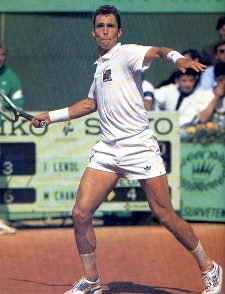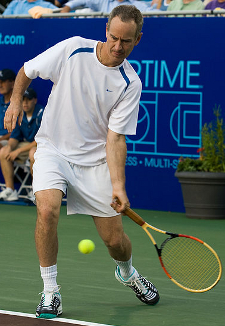SOFTNESS AND STIFFNESSOften, when I face particularly technical topics here on the blog, the greatest difficulty I encounter is to explain the concepts in a clear way to my readers. For this purpose I often use similes, simplifications and examples, and believe it is quite a hard job for me. For instance, while speaking about the curve last week without finding a proper analogy, and I preferred to release a short article with some hints about the evolution of bow making Now I finally found the right parallelism: Ivan Lendl and John Patrick McEnroe !
Ivan Lendl John Patrick Mc Enroe Speaking to those of you who are some years younger than me, I mention these two gentlemen as two of the greatest tennis players of all times, so I decided to take them as a comparison term because, like the curves by Peccatte and Sartory, their playing methods were diametrically opposite. Ivan Lendl was a player with an enormous physical strength, developed throughout hours of grueling training, and very strong fundamentals. He was what in cycling could be called a "passista" (.passista' is a rider capable of maintaining a steady effort for a long time ) He played exclusively from the baseline, hitting strong and on the lines, and above all he was tireless and usually he won by wearing out the opponent. "The strings of the racket were very tense." John Patrick Mc Enroe was exactly the opposite. A playmaker, I may call him the Maradona of tennis. He owned an amazing technical sensibility, he could lift impossible balls as if he did with his hand, his game was unpredictable, played throughout the field, his memorable descents to the net , probably the most beautiful and extrovert tennis ever seen even though he trained very little. "The strings of the racket was very poorly tense." The parallel with the bows lies in the words in bold character i.e.. in the tension of the strings of the racket. Lendl was an impactist , and needed a racket that looked alike the hard ones used in table tennis to download all the power of his arm. Mc Enroe, on the contrary, received the ball and then he accompanied it using the slingshot effect caused by the very loose strings of the racket. The modern curve can be compared to Lendl: stiff , both from the mechanical and sound point of view, stable, concrete, it does not require extreme sensitivity to be exploited at its best . Overall good on every parameter. The ancient one is a balance on instability. Flexible, both in sound and mechanic, the first times you use it you it, you get the impression that it is always on the verge of collapse, but if well done, it never happens. It is much more difficult is to play than to build it but when well executed and well played, it reaches levels unsurpassed by the Sartory one . And now we try to understand why.
Photo 2) violin Bow Dominique Peccatte Unfortunately I can not show here a whole curve for obvious impossibility. Already at a glance the two curves appear very different. The highest point in the Sartory one, i.e. .where the stick is closer to the hair, is located well forward towards the head, more or less placed at three quarters of the bow. In the Peccatte one, on the contrary, the highest point is placed almost midway. This change in position results in a difference of the mechanical-acoustic functioning. As you can see in the photo 1) depicting a Sartory violin bow, the closer you get to the head the more the curve tends to increase. In this way, the tension of the wood fibers increase markedly at that point, and this lead to a greater grip. Nevertheless this performance improvement at the tip has its price. Placing a curve in the forward position, so distant from the handle, means that the forces of the bow are unbalanced . It will be adaptable at the heel, which plays in its favor, but it is very strong in the head. This excessive force at the tip, as mentioned above due to the increase of the curve also increases the attack, decreases a lot the ability to make you feel the string. In addition, since there is much curve forward, in the back side , of course there is less of it, and this makes the bow both hard and low in the middle. This stiffness tends to affect the sound as well. The second picture is a rather classic example of the Peccatte curve. In this case, as you can see on the tip, the bow is almost straight. By giving less curve in the latter part Peccatte removed energy and strength, but increased the sensitivity of the performer's hand. Making it slacken a little bit, the musician can feel the string as if he had it under his index finger. This type of curve is shifted lower than the other, almost halfway. This position equidistant from the head and frog, means that the forces are well balanced. At the heel, where there is the whole arm, there is more curve in order to hold the weight in a proper way. There is less at the tip, because it is the point of maximum opening where the help of the arm weight is minimal, so you balance the imbalance due to posture. The effect of this treatment of the stick is a major strength in the middle , because when you play at that point the bow will yield at another one. That is why I said that the Peccatte curve is a balance on instability, because it will always yield a little, but never at the point where you are playing. This behavior gives the performer a feeling of softness as well as an amazing sound and mechanical ductility, the only problem is that this type of curve is really difficult to do and if it is well carried out, it can become impossible to play. As you can see, even with all the respect I have for a great craftsman as the undisputed Sartory, I am still a follower of the Peccatte curve , at least for the violin and viola. For cello and bass, also considering the minor bow length, I am a bit more flexible. I hope that you liked the similarity between strings and rackets, as you may have guessed I have always been a fan of gift and sensitivity, consequently of McEnroe. Some of you may say that Lendl was more successful and it is true, but when he decreased the rhythm of his trainings, he almost disappeared, because as Sartory he trusted in his physical strength. From his side, McEnroe won his last ATP tournament at the age of forty seven years, after sixteen years of sport inactivity and also in this aspect he is very similar to many Peccatte, Tourte, Pajeot, Persoit that despite the years can still play and in what a way ! My thanks to the site of the auction house "Tarisio", for the beautiful photo gallery to which you can access by clicking on the photos.
Of course we thank the encyclopaedic portal "Wikipedia", just because they exist. Paolo
|
   |










